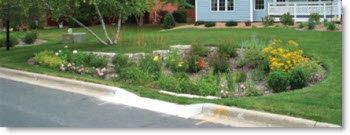What You Can Do: In Your Yard
Quick tips
- Use fertilizer responsibly.
- Don't overwater gardens and yards.
- Landscape with native plants.
- Learn more ways to reduce runoff.
Lawn care:
- Apply fertilizers only when necessary and at the recommended amount.
- Don't apply fertilizer before windy or rainy days.
- Apply fertilizer as close as possible to the period of maximum uptake and growth for grass and other plants, which is usually spring and fall in cool climate, and early and late summer in warm climates.
- Avoid applying fertilizer close to waterways.
- Do not overwater lawns and garden; use a soaker hose, a porous hose that releases water directly to the ground, which can reduce overwatering that carries away fertilizers that would otherwise enrich lawns and gardens.
- Fill fertilizer spreaders on a hard surface so that any spills can be easily cleaned up.
- Properly store unused fertilizers and properly dispose of empty containers.
- Maintain your lawn mowers, snow blowers, chain saws, leaf vacuums and similar outdoor power equipment to reduce nitrogen oxide emissions.
Garden care:

- Plant a rain garden of native plants, shrubs and trees that reduce the amount of fertilizer needed and provide a way for water to soak into the ground.
- Install a rain barrel to collect rainwater; the rainwater can later be used to wash your car or water your plants and lawn.
- Adopt techniques that utilize natural processes to manage stormwater runoff and reduce the impact of impervious surfaces on water quality.
- Use pervious pavers for walkways and low traffic areas to allow water to soak into the ground.
- Install a green roof on your home or business.
- Incorporate best management practices, such as grassed swales, filter strips, or buffer strips on your property to control and temporarily store stormwater runoff.
- Use yard waste, which includes grass clippings and leaves, in mulch or compost for your garden. If this is not an option, prepare all clippings and leaves for community composting, or in barrels or secured papers bags for disposal, which keeps them from washing into streams.
